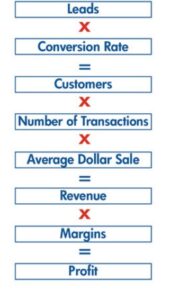For business owners, it’s all too common to become preoccupied in the daily grind of keeping your business afloat, leaving you feeling like there’s never enough time to focus on strategic growth. But fear not! Today, we’re diving into a powerful framework designed to cut through the chaos and offer actionable steps toward boosting profitability. Let’s explore how this framework can help you reclaim control and pave the way for greater success.
What is the 5 Ways Framework?
The “5 Ways” framework is designed to bring clarity to important areas of your business that can be improved to achieve results. These areas include: Leads, Conversion Rate, Number of Transactions, Average Sale Price, and Margins. This focus is crucial because it emphasises the aspects of your business that you can control, rather than outcomes that may be beyond your direct influence.
By mastering this innovative framework, you can significantly boost your business’s profitability. You will gain knowledge on how to strategically and specifically enhance many aspects of your business operations. Small improvements of only 10% in important areas have the potential to compound and increase your entire profit margin by an astounding 61%.
Please note that “10% improvements” will be referenced throughout the blog. This figure is chosen because it represents a realistic and conservative estimate of improvement achievable by implementing the strategies outlined in this blog.

The “5 Ways” Framework
When discussing their aspirations for their businesses, owners often express desires for the outcomes represented in red: more customers, more revenue, and more profit. However, these objectives are highlighted in red for a reason—they are results, not direct points of control. Alternatively, by focusing on improving the factors in blue, you can indirectly influence and drive desired outcomes in red.
Now, let’s break down each element in the equation and provide you with time-tested, proven strategies that you can implement starting today!
Customers
The number of customers a business attracts is determined by two critical factors: the total volume of leads generated and the conversion rate of those leads into paying clients. With this understanding, business owners should focus their efforts on increasing both the number of leads flowing into their sales pipeline and the percentage of those leads that successfully convert into customers.
By optimising lead generation and improving conversion rates, businesses can drive significant growth in their customer base. Let’s examine strategies for lead generation and conversion rates.
Step 1: Leads
Measuring and Tracking
To optimise lead generation, businesses must first measure the number of leads currently coming in and identify their sources.
To better understand your lead sources, implement a system to ask every prospect who contacts you, whether in person, by phone, or email, how they first heard about your business. Were they referred by a friend or customer? Are they returning after a previous purchase? Or did they find you through social media or other online presence? Tracking this data will provide invaluable insights.
Measuring and tracking lead sources can increase lead volume by at least 10%. This is because it helps to identify the most effective marketing channels for your business, therefore meaning, you can allocate more resources to these channels to enhance overall lead generation.
It’s crucial to analyse both short-term (weekly) and long-term (monthly) lead generation results, as some strategies, such as content marketing and search engine optimisation (SEO), can take time to yield their full impact.
Lead magnets
Another effective tactic is offering complementary products to attract new leads. By providing customers with free, valuable supplementary tools or resources, you can showcase the quality of your products or services.
The best part? These lead magnets don’t have to cost you anything if you make use of replicable digital assets like informative content, media, or software tools. Some examples could be a free eBook, a calculator or checklist that helps customers solve common problems, or a short video course.
Offering free, valuable gateway products is a smart strategy to generate new leads and engage prospective customers. By providing something useful upfront, you demonstrate your expertise and build trust. This helps prospective customers get to know your business before they’re asked to buy.
Step 2: Conversion Rate
Boosting your conversion rate ensures that a higher percentage of qualified leads become loyal, paying customers.
Conversion rate analysis
This process begins with meticulously tracking conversion metrics across all salespeople, channels, and systems—including the conversion rates of your website. With this data in hand, you can identify your top-performing salespeople and leverage their strengths to train others on the team.
Sales scripts
Furthermore, recording and analysing sales calls allows you to develop optimised sales scripts. By studying how your best reps handle objections and ask insightful questions to understand prospects’ needs, you can equip your entire sales force with proven techniques for more effective selling.
This systematic approach to improving conversion rates will dramatically increase the number of leads that successfully convert into customers, which will multiply the advantages of your improved lead generation efforts.
Marketing messaging
Conversion rates are heavily impacted by how well your marketing messaging aligns with your actual product or service offering. Poorly targeted marketing that fails to accurately represent what you provide will inevitably lead to a low conversion rate, no matter how many leads come in the door.
To optimise conversions, you need to ensure your marketing content speaks directly to your ideal target customer and clearly communicates the value proposition of your offering. Tightening up that marketing-to-product alignment will go a long way in boosting conversion rates.
Employing these tactics could absolutely yield a 10% or greater increase in conversion rate and when combined with the lead generation optimisations, these changes have the potential to drive tremendous customer growth.
Having explored methods for increasing customers via increased leads and enhanced conversions, let’s now transition our attention to tactics aimed at maximising revenue from your existing customer base.
Revenue
According to the “5 Ways” framework, revenue is the product of three key components:
- The number of customers
- The number of transactions per customer
- The average sale price
After having looked at ways to grow your customer base, let’s now investigate methods to encourage them to make larger, more frequent purchases.
Step 3: Number of Transactions
Did you know that by regularly emailing your contact list and staying in touch with past customers, you can significantly increase the likelihood of them making repeat purchases? When you invest considerable time and money into acquiring clients, failing to keep them engaged with your company and products essentially wastes their lifetime value. Previous clients need reminders of your services to encourage them to buy from you again.
One effective way to inspire customer loyalty is by offering special deals to your existing customers. Offering these promotional deals can save you money that would be spent on customer acquisition costs.
A higher ROI can be achieved when marketing to your existing list because:
- They are cheaper to contact as you should already have their contact details
- They have bought from you before, so you know your marketing messaging resonates with them
- They have experienced your high-quality goods or services and have been convinced by your quality (we hope)
As long as the savings on client acquisition costs outweigh the slight loss of margins from selling the special offer, this marketing approach will save you money.
Another significant benefit is that the margin loss is a fixed cost incurred only upon making a sale, whereas advertising costs do not guarantee a fixed return on ad spend, making them riskier.
Providing a special offer is a win-win for you and your customers as they get a better deal, and you get cheaper, risk-free marketing.
Step 4: Average sale price
Raising prices
Do you want to know how to boost your average sale price by 10%?
The solution is surprisingly simple: raise all prices by 10%. While this may seem daunting initially, the benefits of a strategic price increase are numerous.
As a business owner, it can be challenging to decide whether to raise prices or not. One common concern is the fear of losing customers. However, it’s worth noting that in reality, the number of customers lost is often much lower than anticipated.
Additionally, the most likely customer type to leave are the problematic customers, this is because they are the most likely to make buying decisions based on price alone and not the amazing value your business provides.
The ability to eliminate serving these problematic customer types is a majorly beneficial because it frees up time and energy to provide an amazing experience for your ideal, profitable clients who will happily refer more of their like-minded peers. This not only improves profit margins but also enhances the customer experience and positively impacts financial metrics.
This will enable you to allocate resources more effectively, improving customer satisfaction, and ultimately grow your business.
Cross selling
Cross-selling complementary products and services to existing clients is another powerful strategy that can boost your revenue. For instance, if you’re providing IT services to a client, you could also offer them your marketing expertise. By doing so, you can provide them with a more comprehensive beneficial service while also increasing the revenue generated from the same client.
So, by taking a confident stance and implementing a well-planned price increase, combined with strategic cross-selling, your business will simultaneously:
- Boost revenues
- Rid yourself of unprofitable client relationships
- Attract higher-calibre customers
- Reinforce premium brand perceptions.
Implementing the aforementioned tactics will comfortably yield a 10% increase in average sale price.
As we conclude our section on optimizing average sale price, let’s now discuss profit.
Profit
Profit – the ultimate goal that drives every business forward. So, how can we maximise profits using this framework? Simply put, profit is the product of revenue and margin.
We’ve covered tactics to drive exponential revenue growth through acquiring more customers, increasing transaction frequency, and boosting average order values. Now let’s focus on strategies to improve those all-important profit margins.
Step 5: Margins
Margins are the first thing you should focus on, as they determine if your business is profitable. Simply increasing the number of leads won’t help if your business is running at a loss. Therefore, it is essential to focus on improving your margins first. So how do we go about fixing them?
There are many ways to reduce wasted time and money in a business. One of the most effective is systemising repetitive tasks.
Systemising repetitive tasks in business is crucial for several reasons, firstly it can improve productivity of your staff by streamlining their workflow and eliminating unnecessary manual work. When employees no longer have to spend time on repetitive tasks, they can allocate their energy and expertise to more meaningful activities, ultimately increasing their overall productivity.
Systemising also improves consistency because the same process is used regardless of the employee, this helps maintain quality and avoid errors.
For example, adding a detailed FAQ section in your website could cut down on the number of calls your businesses get substantially, saving your staff from the burden of answering the phone repeatedly. This could save them hours per day that they could spend on revenue generating tasks.
Another effective strategy for enhancing margins is by improving production processes. Production processes encompass the series of steps and activities required for manufacturing goods or delivering services. Enhancing these processes is beneficial for several reasons, notably in eliminating waste.
For instance, inefficient energy tools in your factory can lead to excessive energy costs. By replacing such equipment, you can significantly reduce energy expenses, thereby positively impacting your margins.
So where does the 61% boost in profitability come into all this?
Throughout this blog, we’ve delved into various strategies aimed at enhancing your business. While each tactic discussed today has the potential to provide incremental improvements or address specific weaknesses on its own, it’s the synergistic combination of these elements that truly amplifies their benefits. But you may find yourself asking where does the 61% increase in profitability come into it?
Well, to find that out we need to do some math. Yes, I know – stay with me. Here are the numbers for this example business:

(The graphic portrays a 10% increase from previous business figures, demonstrated by the transformation of 4000 leads into 4400.)
Because the 5 steps are multiplied not added they provide leveraged outsized returns.
As you can see in the example above, with a few small 10% changes driven by strategic shifts, we have been able to make this theoretical business 61% more profitable. But these results don’t have to remain theoretical — they can become a reality for you and your business, just as they have for thousands of business owners across the world that we have worked with.
If you would like help implementing the 5 Steps Framework into your business and accessing hundreds of strategies to improve the 5 core areas of your company, speak to one of our expert business coaches today!
Book Your Free Coaching Session Today





